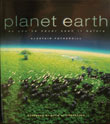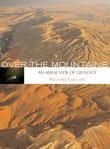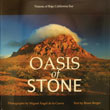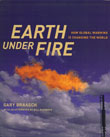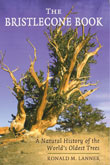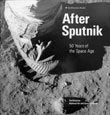|
GEOMEDIA
Check out the latest On the Web links, your connection to earth science friendly Web sites. The popular Geomedia feature is now available by topic.
Museums: Blending of Art and Science
Products: Holiday Gifts for Geologists
Books: Holiday On the Shelf
Mailing: A Scientific Way to Mail Your Holiday Cards
Blending of Art and Science
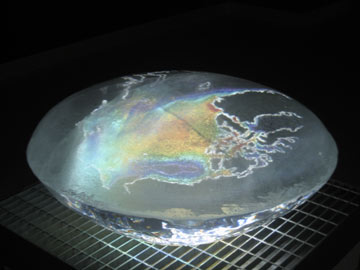 Lillian Ball |
| Lillian Ball,
66 Degrees, 32 minutes, 50 Years Map morph animations projected on ice (shown in photo) or ice water (as currently exhibited) 2007 |
At first glance, art and science may appear to be separate worlds, but the exhibition Weather Report: Art and Climate Change currently on display at the Boulder Museum of Contemporary Art in Colorado shows that the two can meld together. The show, which runs through Dec. 21, features the work of 51 artists who — based on input from numerous scientists — address issues such as pollution, floods, environmental degradation and climate change through photographs, sculptures, videos and other media.
Weather Report is the largest component of this year’s EcoArts event, which brings together scientific, environmental and arts organizations to raise awareness about climate change and a sustainable future, a job that art is uniquely positioned to do, says curator Lucy R. Lippard. “[Artists] are freer to imagine outcomes than scholars and … can make the realities of climate change more vivid and immediate than any other medium in this visually oriented society,” she says.
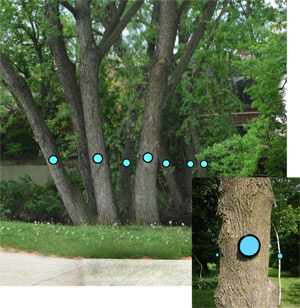 Courtesy of Mary Miss |
| Mary Miss,
Connect the Dots: Mapping the High Water, Hazards and History of Boulder Creek A study for outdoor work in Boulder, Colo. Mixed media |
One example of a vivid illustration of possible future scenarios resulting from climate change is Mary Miss’ Connect the Dots: Mapping the High Water, Hazards and History of Boulder Creek. Based on data compiled by the city of Boulder, Miss walked around Boulder and marked where water would reach during a potential 500-year flood by attaching more than 200 blue paint can lids to trees and buildings across the city of Boulder: A stroll through town illustrates that hardly any buildings would survive such a scenario, as the guides, available at the museum, show you.
Chris Jordan’s series of inkjet prints called Running the Numbers: An American Self-Portrait makes a statement about our consumer society. Plastic Bottles portrays 2 million water and soda bottles — the amount consumed in the United States every five minutes. The individual bottles are depicted in such minute scale that the entire piece looks like an abstract pattern unless viewed from very close up. Jordan used the same approach in Denali Denial, a black and white inkjet print of Alaska’s Mount Denali assembled from 24,000 tiny logos of GMC’s Yukon Denali, an SUV. The number equals six weeks of sales of the SUV model in 2004, according to the exhibit. Showing this piece in Boulder is particularly appropriate since the city — though renowned for its eco-friendly spirit — has the largest percentage of SUVs per capita in the entire country, according to the museum.
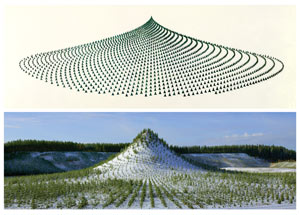 Agnes Denes |
| Agnes Denes,
Tree Mountain - A Living Time Capsule—11,000 Trees, 11,000 People, 400 Years Top image: View of original design drawing from 1983. Bottom image: Winter view from 2001 of actual mountain/forest with the mathematical pattern beginning to show. Color photograph on foam-board. 1983, 2001 |
But Weather Report reaches far beyond Boulder’s city limits. Agnes Denes’ Tree Mountain — A Living Times Capsule — 11,000 Trees, 11,000 People, 400 Years is one such example. Between 1992 and 1996, 11,000 people from around the world planted 11,000 trees in a symmetrical pattern atop a huge human-made mountain in Finland, as part of a land reclamation project. The mountain — 420 meters long, 270 meters wide and 28 meters high — will one day become a man-made forest and is supposed to be maintained for 400 years. Denes’ photographs that document various stages of the project, including one picture that shows the bare mountain of dirt and one in which the trees have grown a meter high, are on display in Weather Report.
Weather Report is a new and unusual approach of communicating the possible implications of climate change, and its direct, confrontational style examines climate change in a way that few news articles or scientific reports do.
Even though the art show is not online, an exhibition podcast is available at www.bmoca.org/education/multimedia.php that describes the individual pieces and contains an interview with curator Lucy R. Lippard. If you want to see the exhibition without going to Boulder, you can order a Weather Report catalog from the same Web site.
Holiday Gifts for Geologists
 Hugg-a-Planet images |
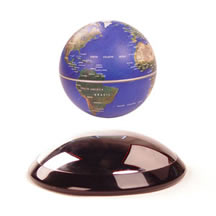 Levitron/Creative Gifts, Inc. |
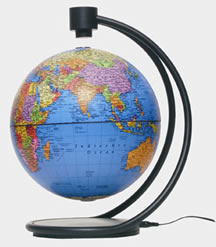 Fascinations |
This holiday season, gifts and gadgets abound that are sure to please the budding — or tried and true — geologist in your family. Geotimes scoured the shelves for a few fun ones to tell you about this year.
GeoDecorate!
- The Hugg-A-Planet ($9.95 and up at www.peacetoys.com) collection of cute, plush, eco-friendly toys includes several different planets: three sizes of Earth that show countries, oceans and 600 different sites; an Earth with an attached moon that shows the lunar landscape and some of the landing sites; and Huggable Mars, which shows more than 400 places of interest, from the Viking and Mars Rover landing sites to geological spots such as Olympus Mons, Mars’ many volcanoes and craters, and the icy poles.
- The beachball evolves: Inflatable Earthball ($18.00 at www.earthball.com) is the product of a collaboration between NASA and cartographic design company Orbis. Its surface, showing oceans, mountains and atmosphere, is made up of thousands of satellite images of Earth, circa 2003, creating a highly accurate (albeit blow-up) version of the planet. Although this satellite view of the world is without geopolitical borders, it does have glow-in-the-dark cities showing how Earth appears at night from space.
- Levitating globes ($75.95 and up, various vendors) don’t have a magnetosphere, but then, they don’t need one: Propped up on a desk or bookshelf far from solar storms (and not too close to your computer), these electromagnetically suspended globes can float or gently rotate in perfect safety. Consider the elegant 4-inch-diameter Levitron AG Anti-Gravity Globe, which floats freely over a specially engineered, curved mirror base ($89.95 at www.earthtechproducts.com), or one of the Stellanova levitating globes, such as classic planet Earth or antique-map Earth, each suspended within an arcing base ($75.95 and $79.95, both at www.livesciencestore.com).
- With the help of either a small, tabletop projector (Moon Wall Projector, $24.95 at shopping.discovery.com) or a remote-controlled moon that hangs on the wall (Moon in My Room, $19.99 at www.target.com), kids (and adults) can bask in the glow of a realistic moonscape (scaled down to room size). The Moon Wall Projector takes its projected moon through a complete lunar cycle in one hour. With the Moon in My Room controller, you can speed up the process or leave it on automatic (Moon in My Room also has a built-in light sensor that automatically turns it on in a darkened room).
- Complete with bonus, newly downgraded celestial object Pluto, the Electric Solar System Mobile and Light ($28.95 at www.telescope.com), a motorized scale model of the solar system with a light-up sun at the center mounts to the ceiling; the planets and Pluto slowly orbit around the ceiling with the aid of a remote control/light pointer and a few batteries.
Fun in a Box
Science is fun! And you might even be able to convince your kids of this with the help of one of these learning kits, which contain all the necessary ingredients to teach budding geologists and rock stars about the mysteries of Earth and space. Here are a few to try:
- National Geographic’s Earthquakes and Volcanoes Kit ($26.95 at www.livesciencestore.com) is not just a learning tool; it’s also a how-to. In addition to a full-color book about the world’s earthquakes and volcanoes, the kit includes volcanic rocks, instructions to build a seismograph and the ingredients to build and erupt two different types of model volcanoes.
- Magnets in Motion ($23.95 at www.dowlingmagnets.com) shows how magnets make the world go ‘round, with iron filings, ceramic and neodymium magnets, and other bits and pieces. Learn how to generate electric currents, how subway brakes work (haven’t you always wanted to know?) and other activities.
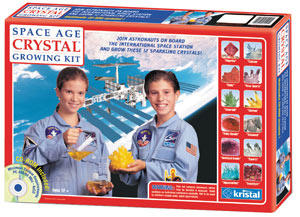
Kristal Educational, Inc - The Space Age Crystal Growing Kit ($33.95 at www.kristalcanada.com) lets you grow crystals just like they do on the International Space Station. The kit contains geode molds, chemicals and containers, and other tools to grow 12 kinds of colorful crystals. It comes with an International Space Station CD-ROM.
- The Orion Solarscope Sun Projection Theater ($59.95 at www.telescope.com) doesn’t project a simulated sun onto your wall — it lets you stare at the real sun without going blind. By the clever use of optics, the easy-to-assemble solarscope projects an image of the sun onto a screen inside a shaded cardboard hood, allowing for safe viewing of sunspots and solar eclipses.
Paleo Products
If you’re looking for the right gift to brighten the day of the paleontologist or fossil hound in your life, you might consider these:
- For those who want a museum-quality piece to sit back and admire (or tremble in fear), the Japanese company Favorite Collection has created a range of highly accurate skeleton and finished scale models, including the Velociraptor Skeleton Model ($249.99 at www.livesciencestore.com). Nearly three feet long and scary, the model is constructed from polyresin and affixed to a wood base with a brass plaque engraved with the dino’s name. Also consider Favorite Collection’s finished (meaning: with skin) scale models, including Deinonychus and Stegosaurus ($59.00 each at www.dinostoreus.com).
- For budding paleontologists who want to get in there and dig out a skeleton for themselves, Spark offers the Ice Shattering Mammoth Dig ($24.95 at shopping.discovery.com), which simulates an excavation. First, you can use a special mold to freeze your mammoth skeleton in ice, and then carefully chip away at it with a set of excavation tools, which includes a surgical saw, tweezers and an ice chisel.
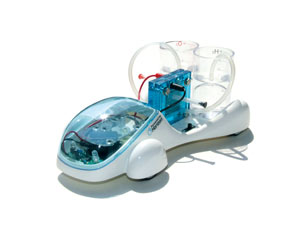 Horizon Fuel Cell Technologies |
Good for You, Good for Earth
Blend do-gooder urges with cool techy fun with one of these solar- or hydrogen-power do-it-yourself kits:
- The Thames and Kosmos Physics Solar Workshop ($47.99 at www.amazon.com) — developed in association with Greenpeace in Germany — is a primer on all things solar-powered. It includes 12 building projects that teach you to build solar-powered machines from tractors to airplanes, and 30 experiments to explore how solar cells transform light into electrical (and ultimately mechanical) energy.
- The Amphibious Solar Vehicle Kit ($38.95 at www.sciencelabs.com) gives you the plans and parts to build a solar-cell-powered futuristic vehicle — part car, part boat — that works on land and in the water.
- Powered by tap water, the Estes Hydrogen Fuel Rocket ($36.95 at www.livesciencestore.com) includes a hydrogen fuel generating launch system, launch pad, four-point system check, remote ignition button, propellant crystals and a rocket.
- Horizon’s Hydrocar ($85.00 at store.horizonfuelcell.com) is a glimpse into the future: The miniature car uses 100 percent clean hydrogen fuel — specifically, a reversible Polymer Electrolyte Membrane fuel cell — to go vroom. You can also watch as oxygen and hydrogen gases form in two transparent containers at the back of the vehicle. Bonus: The fuel cell can also be removed from the car to power other gadgets. No batteries required: Just add water.
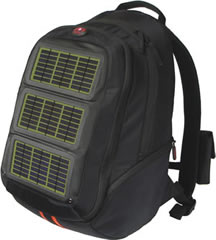 Voltaic Systems |
Geeking it up in the great outdoors
- Charging up devices can be tricky when charging up hills or hiking through the back forty. If you absolutely need your PDA, camera or MP3 player charged and ready, however, the Voltaic Solar Bags ($199 and up at www.voltaicsystems.com) might be the way to go. Each bag is equipped with 11 standard adaptors to connect to small electronic devices, and contains three lightweight, waterproof solar panels that generate up to four watts of power, as well as a lithium ion battery pack to store any surplus power. Choose between the messenger, converter, daypack and backpack sizes, depending on how far you plan to go and how much power you think you’ll need.
- Is there lightning nearby? By the time your hair stands on end it may already be too late. The pager-sized StrikeAlert Lightning Detector ($69.00 at www.weathershop.com), however, can detect strikes that are up to 64 kilometers away, tell you roughly how far away they are and give you time to find shelter.
- For snowy hikes or ski trips, the Mammut Pulse Barryvox Avalanche Transceiver ($400 at www.mammutusa.com) could save your life. The signal beacon not only helps a rescue team locate you, it also contains an accelerometer that detects if you’re still breathing and can radio the results to your rescuers.
- Want to navigate like the pros? The multipurpose Brunton Eclipse Professional Compass ($89.95 at www.backcountry.com) isn’t your average compass. It was designed for surveyors, environmental engineers and geologists, with three clinometer systems and a bubble level to measure inclines and get strike and dip measurements. The Eclipse Pro also uses Brunton’s circle-over-circle alignment system, which keeps you on track.
Holiday On the Shelf
If you're stumped by what to get the geology buff in your life for the holidays this year, then you might want to consider an earth-science-themed book of photography. To make your search for the perfect picture book easier, the Geotimes staff has chosen a few favorites from the past year. Filled with glossy photos of some of the most awe-inspiring places on Earth, any one of these books is bound to please even the most discriminating geo-minded reader.
A Scientific Way to Mail Your Holiday Cards
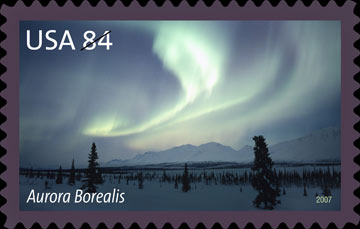 © USPS. Used with permission. All rights reserved. |
The U.S. Postal Service is offering many different ways to show your science inclination this holiday season. On Oct. 1, the post office released Polar Lights stamps to commemorate the International Polar Year (IPY), the latest in a line of stamps relating to science that includes everything from the wealth of the wetlands in Florida to the wonders of Yosemite National Park. In fact, several countries with polar interests are offering such commemorative stamps during IPY, a multi-nation interdisciplinary polar research program that runs from March 2007 through March 2009.
In the United States, the Polar Lights stamps feature both the southern lights (aurora australis) and the northern lights (aurora borealis), and bring attention to the role of polar research in studying these phenomena and other Arctic processes, according to the postal service. Canada, Sweden, Norway, Denmark, Greenland, Iceland and Finland all released polar stamps this year as well. And France, where IPY was launched, issued stamps celebrating both the 50th anniversary of Sputnik and the International Geophysical Year (1958).
If you’re not a fan of the polar stamps, the U.S. Postal Service has other geoscience-themed stamps to use on your holiday cards this season. In addition to beautiful stamps of various national parks, you might want to use the “Wonders of America: Land of Superlatives” stamps, a fun collection of the biggest and the best in America. This collection includes 40 different places, structures, plants and animals, such as “Windiest Place,” at Mount Washington, N.H., “Largest Glacier,” which is the Bering Glacier in Alaska, and “Most Active Volcano” at Hawaii’s Kilauea.
Another fun — and educational — collection is the Alpine Tundra stamps, which is the ninth set in a series designed to “promote appreciation of major plant and animal communities in the United States,” according to the postal service. The Alpine Tundra stamps include 24 plant and animal species, all suggested by scientists, that you might encounter on a trek through the tundra in Rocky Mountain National Park, postal officials say.
This year, you can send off your holiday mailings and stamp your support for science at the same time.

 Subscribe
Subscribe

